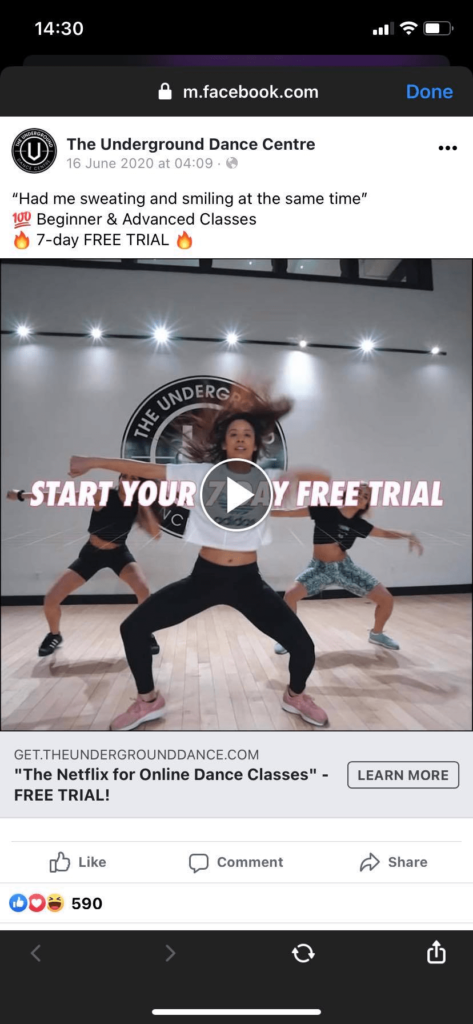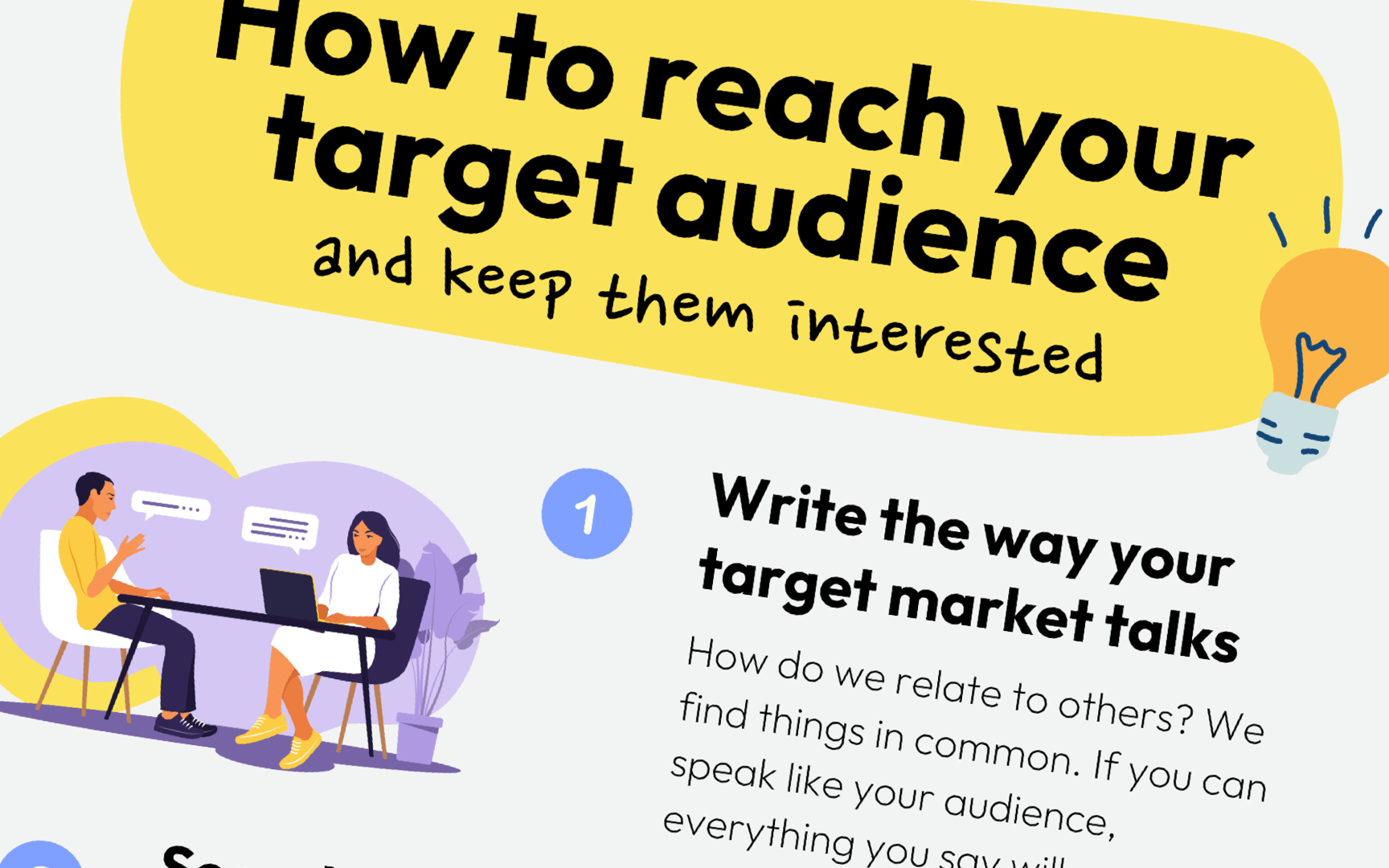Content marketing is the best way to reach your target audience. Whether that’s through social posts, email campaigns, or targeted ads. It all has to be engaging and relevant.
But just because it’s common knowledge, doesn’t mean everyone is doing it well. In fact, most content is generic and easily forgotten. Because a lot of businesses don’t really know who’s paying for their product.
Audience research lies at the heart of success. Once you know enough about them, the process becomes easy. Then you can start getting inventive and create consistent content they’ll love.
Here are 7 ways to reach your target audience and keep them interested
- Write the way your target market talks
- See what they’re saying on social media
- Check on your competitors
- Start a referral program (and make it fun)
- Create unique marketing campaigns
- Try targeted ads
- Keep in touch (but don’t be annoying)

Write the way your target market talks
Your marketing strategy starts with research. A lot of it. Because it takes a lot of time to build a loyal customer base. And you won’t get a group of people to that stage if they can’t relate to your company.
So, how do we relate to others? We find things in common. And potential customers have to see your brand values match theirs. So, everything you write online feeds into this personality.
You know your ideal customers. But who are your actual ones? Buyer personas can be helpful to create to find out. But only if a lot of market research goes into them. Not just: Fred is in his 40s and likes pizza.

But let’s assume you know who they are. Because you’re trying to find out how to reach these people. Now, you need to speak to them in a way that makes them want to take action. That’s how you form your brand voice.
This will be unique to your business. You might have a cheeky, upbeat tone. Or a more casual, relaxed one. But one tactic that applies to everyone is writing how your target consumers talk. How we all talk.
Conversational copy isn’t salesy. It doesn’t bother with jargon or big, complicated words. Especially when you can say it simpler.

It’s so much easier to write long, rambly sentences. It actually takes more work to stick to the point. So, this kind of copywriting takes time to learn. And you’ll always be improving.
It works for every industry. But just how informal you are is up to you.

It’s also a huge part of keyword research for content writing. Because you want to rank for phrases your audience actually uses.

You can even use it for smaller details like your 404 error pages:

Or your cookies opt-in message:

Because all these details make up your customer journey. So, keeping every part of your site fun makes for an awesome UX (user experience). And speaking to your target audience in a way they recognize makes them way more likely to stick around.
See what they’re saying on social media
Where do lots of people go to rant and moan? Their friends or parents’ houses? Not anymore. If you need to air a grievance, head to social media. These echo chambers mean you’ll always have people with similar experiences ready to agree with you.
Because of this, they’re some of the best places to learn about current customers’ pain points. But different demographics will hang out on certain platforms. With varying privacy settings.
Social listening can help by tracking keywords and mentions on social media channels like Twitter, Facebook, and LinkedIn. These tools do the hard work for you. You just tell them what to listen out for and they’ll show you the results.
It shouldn’t always be about you, though. You want to learn as much as you can about the lives of your target audience. Things like:
- Their likes and dislikes
- What motivates them
- Which other companies they buy from
- How much they’re spending
It’s a way to uncover questions and conversations about your industry. You can also create a more in-depth template for your target consumer. And that way, you’ll have a better idea of how to appeal to these people with your social media marketing efforts.
It also gives you tons of opportunities to jump in and join the chat. But this doesn’t mean plugging yourself. Social media engagement should always be genuine. If you keep adding value, you’ll make people curious about you. Then you’ll grow your following organically much faster.
Also check out hashtags and trending topics relevant to your industry too. But don’t ask for sales or followers. Just join the chat and get your name out there. Most companies use social media to increase brand awareness. And you want to be known as a funny or knowledgeable
contributor. Not a shameless self-promoter.
Social media can help you develop deeper relationships with potential customers. Even if it’s just to say thank you.
It’s also a way to keep top-of-mind for your target audience. That way, you won’t be forgotten about.
Check on your competitors
Your marketing plan for your target audience shouldn’t be based on guesswork. You need the facts. So, tools like Google Analytics can provide data. Like your customers’ demographic information.
But what if you’re a startup or new small business? Chances are, you’ll still have competition. Unless you’ve created some new technology, there will always be others in your niche. And you can use their marketing efforts as inspiration for your own.

You should have a marketing message that differentiates you. A USP (unique selling point). Even in an industry as saturated as mattresses, they all have them:
- Simba Sleep – Europe’s best-reviewed mattress in a box
- Nectar Sleep – “most comfortable mattress”
- Avocado – 100% certified organic and nontoxic
- Emma – UK’s most-awarded mattress
- Purple – “the best mattress tech advancement in 80 years”
You’re all competing for the attention of the same group of people. So, find out what your competitors are doing to reach their target audience. How are they standing out?
Simba Sleep came up with a cheeky marketing campaign that caught my eye. Their tv ad “For Grown Ups” ended with the tagline “Because you do more in bed than just sleep.”
This was so different from anything else other manufacturers were doing. Because it went down a slightly more risqué route. So, when it came time to move house, I actually remembered the ad and bought one.
You can do the same with your marketing strategy. Take what makes you different and run with it. It doesn’t have to be a long-term campaign. It could just be enough to grab your target audience’s attention at the time with something different.
Start a referral program (and make it fun)
We know customer retention is cheaper than acquisition. But it doesn’t make it any easier. Tempting new customers in is one thing. Keeping them is another. And you can’t afford to forget about someone once they’ve purchased or downloaded.
You want to reward loyalty. Because then people will talk about you. And word-of-mouth marketing is directly responsible for 90% of purchases. So, how can you create a referral program that gets people excited?

Gamification is a fun way to reach your current customers. And keep them interested in your brand. Because you can make it unique. One of my favorite brands doing this is Good Pair Days. It’s a personalized wine subscription with a fresh, modern marketing strategy.
There are tons of ways to earn points on the site and get rewards. The more you interact, the more merch you’re sent with your monthly box of wine. From bottle stoppers to cheeseboards and wine glasses. And the top way to earn is through referring others.

I found this company through an Instagram ad. And I interact with their site more than any other brand I buy from. Because who doesn’t want to get random gifts along with a subscription they love?

They even give you bonus points, just ‘cause. If that isn’t a way to keep your target audience on board, I don’t know what is. It’s a small gesture but it feels big when other companies are doing nothing.

Remember, all this wouldn’t matter if the service was poor. So, you need to make sure all stages of your customer journey are engaging. And that all parts work as they should. Once you’ve got a solid service, you can start getting creative.
Create unique marketing campaigns
Content marketing is the most reliable way to reach your target audience online. And all business owners should be doing it. Or outsourcing if you don’t have time.
SEO (search engine optimization) helps your target audience find you. It has the most longevity out of all the tactics in this guide. So, your content strategy is one of the most important parts of your marketing plan.
And you can create so many different formats:
- Step-by-step guides
- Downloadable templates
- Social media videos
- Interactive infographics
- Presentations and slideshows
- Webinars and podcasts
- Quizzes and tools

But you can’t just write a blog post and expect that to rank and bring in tons of traffic. If you’re a new business, you might want to build a bank of content first. Because you need to keep your audience interested once you’ve got their attention.
To give all your content the best chance of performing well, you have to do a few things:
- Use keyword research when planning
- Fill it with visuals, facts, and figures
- Mix up the types of content you create
- Be consistent with creating and posting
- Promote it once it’s live
As soon as we log onto our favorite social apps, we’re drowning in content. Most of it instantly forgotten. So, yours also needs to stand out. It has to be memorable, like Simba Sleep. The type you create will be based on your brand’s personality. So, you need to have a unique one.
You should know where your audience hangs out. So, that’ll dictate where you post your content. Your customers might frequent:
- Social media
- Search engines
- Community sites (Reddit, Quora, etc.)
- Niche online communities
- Other blogs
So, you might want to try guest blogging on other sites. Or organiaze take-overs on other brand’s Instagram Stories. Wherever your target audience is, reach them there. And make sure they remember you.
Try targeted ads
You may be a talented entrepreneur but digital marketing ads are tricky. Especially those on social media platforms. It’s so easy to hit “Boost” and expect results. But without proper targeting, you’ll find most have little to no impact.
Ads are meant to target a specific group of consumers at the right time. Because your copy should be based on purchase intent. There’s no point saying “Buy now” if people on your social channels aren’t ready to. But then again, some people might be.

That’s why ads are so difficult. A lot of research needs to go in before you send something live. You need to be sure it’s going to be highly relevant. Because you need to put in money up front.
You can target with filters like:
- Gender
- Age
- Interests
- Relationship status
- Location
- Education
You also need to make sure you’re on the right platform in the first place. For moms, you might find more success with Facebook Ads. For young teens, try TikTok.
This is why audience research is so important. And it’s not about just the copy either. Your visual content is probably the most important element. Because marketers tend to find the more words, the less interest.
Targeted social ads run alongside posts from people’s friends and family. So, you want to blend in a bit. Show how your product or service benefits people’s lives. Not just cutting in with a wall of text talking about how great it is.
You can also go further down the “show don’t tell” route and try video. And make the value people that sign up will be getting extra obvious:

You can also consider strategic partnerships with other brands. This opens you up to a whole new target audience too. Obviously, I don’t mean your competitors. But someone in a related niche to yours. If you’re a vegan food brand, maybe some kind of natural drink.
Keep in touch (but don’t be annoying)
All your marketing messaging should show potential customers the value of your product. Before and after they buy. Through social posts, ad copy, or CTAs (calls-to-action).
Marketing messages are how you reach your target audience directly. And they’re especially effective in email campaigns. They can alert users about new products. Or helpful content you think they’d be interested in.

But lots of sites get them wrong. We’ve all been there. You buy something from a site once. Then you hear from them every day with generic, annoying emails. So, how often should you contact your email list?
Weekly and multiple times per month are the most common answers. But it’ll depend on your industry. One insurance company increased revenue by 45% by sending more emails. While an eCommerce store’s dropped by 30% after they added a weekly newsletter.

Fashion brands can usually send more. Because people like to browse even if they’re not ready to buy. But it all depends on your customers’ purchase cycle. If they’re buying more frequently, you can get in touch more. If it’s every few months, you’ll want to cut down to match.
Email marketing isn’t complicated. But there are a few golden rules to remember:
- Personalized emails should be a given
- Build relationships instead of constantly promoting
- Segment your list and automate with tools
- Put a lot of thought into your subject line
- A/B test to find what works best
- Always be relevant and share value
A bigger list doesn’t mean higher engagement. So, don’t be afraid of unsubscribers. As long as they’re not happening on a huge scale. Because that means a more targeted group that is more likely to take you up on your offers.
Conclusion
Reaching your target audience can only happen once you know them. Marketing isn’t about a one-time sale. It’s about building relationships. Not enough is put into audience research. When it should really be the most important thing.
Finding where they hang out online helps get your content in front of them. Compare and adjust your pricing with the other products they take selfies with on Instagram. Show you match their values they Tweet about.
If you already have an established business, you have data to work from. So, you’re in a better position. Startups, think about narrowing down your target audience before marketing. What can you start doing today to get to know your potential customers better?
Which brands do a great job of keeping their target audience interested? Which are your favorite brands to buy from? Have you seen any memorable content recently? Let us know in the comments below.





